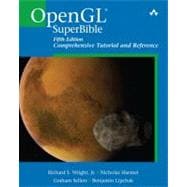OpenGL® SuperBible, Fifth Edition is the definitive programmer’s guide, tutorial, and reference for the world’s leading 3D API for real-time computer graphics, OpenGL 3.3. The best all-around introduction to OpenGL for developers at all levels of experience, it clearly explains both the API and essential associated programming concepts. Readers will find up-to-date, hands-on guidance on all facets of modern OpenGL development, including transformations, texture mapping, shaders, advanced buffers, geometry management, and much more. Fully revised to reflect ARB’s latest official specification (3.3), this edition also contains a new start-to-finish tutorial on OpenGL for the iPhone, iPod touch, and iPad.
Coverage includes
- A practical introduction to the essentials of real-time 3D graphics
- Core OpenGL 3.3 techniques for rendering, transformations, and texturing
- Writing your own shaders, with examples to get you started
- Cross-platform OpenGL: Windows (including Windows 7), Mac OS X, GNU/Linux, UNIX, and embedded systems
- OpenGL programming for iPhone, iPod touch, and iPad: step-by-step guidance and complete example programs
- Advanced buffer techniques, including full-definition rendering with floating point buffers and textures
- Fragment operations: controlling the end of the graphics pipeline
- Advanced shader usage and geometry management
- A fully updated API reference, now based on the official ARB (Core) OpenGL 3.3 manual pages
- New bonus materials and sample code on a companion Web site, www.starstonesoftware.com/OpenGL
Part of the OpenGL Technical Library–The official knowledge resource for OpenGL developers
The OpenGL Technical Library provides tutorial and reference books for OpenGL. The Library enables programmers to gain a practical understanding of OpenGL and shows them how to unlock its full potential. Originally developed by SGI, the Library continues to evolve under the auspices of the OpenGL Architecture Review Board (ARB) Steering Group (now part of the Khronos Group), an industry consortium responsible for guiding the evolution of OpenGL and related technologies.









